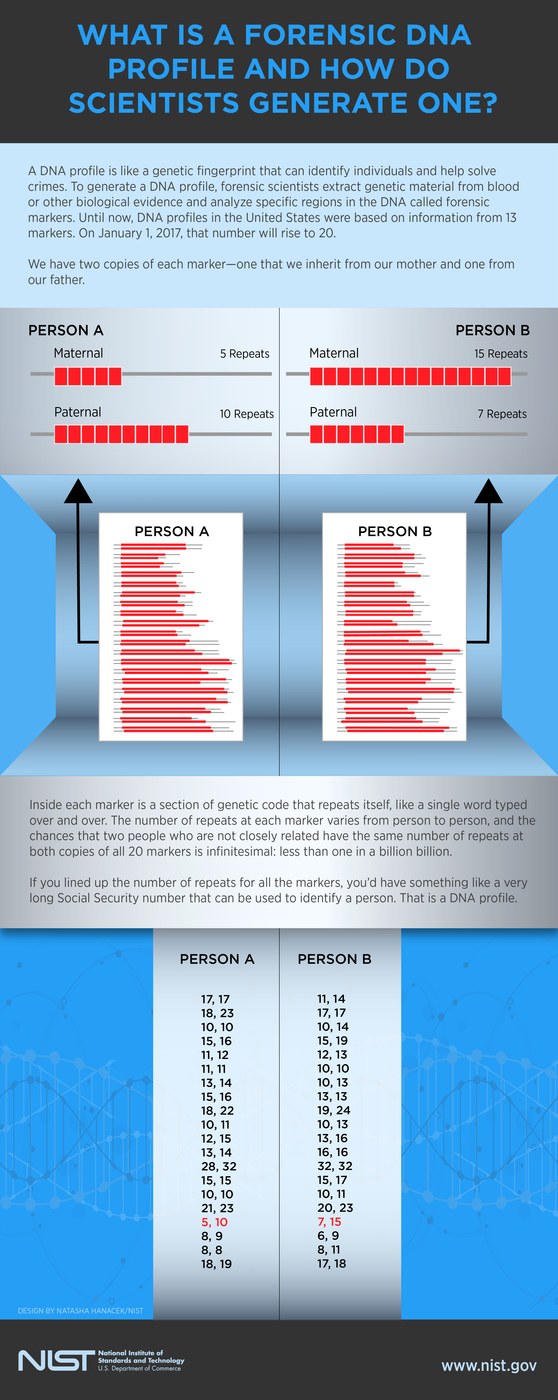NIST Research Enables Enhanced DNA “Fingerprints”
Starting January 1, DNA profiles will include more data, making them even more powerful at solving cases.
As the new year approaches, forensic labs across the country are gearing up for a big change in the way they generate DNA profiles, the genetic fingerprints so useful in solving crimes and identifying the remains of missing persons. Forensic experts produce DNA profiles by extracting genetic material from blood or other biological evidence and analyzing sites in the DNA called markers.


To meet the new year’s deadline, all labs that submit profiles to NDIS have had to upgrade their protocols and meet a series of quality assurance standards set by the FBI.
This upgrade is necessary in part due to the rapid growth of the system, which has expanded to include nearly 16 million profiles related to criminal investigations and 30,000 related to missing persons. NDIS now has to add more markers for the same reason a growing city might have to add a new area code. It ensures that everyone can have their own number.
In addition, this upgrade will make international DNA searches more effective by increasing the number of markers that the U.S. system has in common with those of other nations. The number of markers used in both the United States and Europe, for example, will rise from eight to 15.
The new markers will also help solve a problem that often comes up in cases where the DNA has started to break down. In those cases, forensic analysts can’t always get a read on all 13 markers, and they end up with a partial profile.
“If you’ve got a case where seven markers drop out, the statistics may be too weak to establish an identity,” said Mike Coble, a research geneticist at NIST. When that happens, a perpetrator might escape the notice of investigators and remain free to commit more crimes.
“But if you start with 20 markers, seven can drop out and you’ll still have what’s considered a full profile today,” Coble said.
Of the seven new NDIS markers, three were first identified by Coble and his colleagues at NIST. And those three markers were chosen because they are particularly useful in cases where the DNA has started to break down.
A Fragile Molecule
A marker is a stretch of DNA that occurs at a specific location within a person’s total set of genes, just as a building occurs at a specific address within a city. And like many buildings, forensic markers aren’t very interesting inside.
“We’ve intentionally chosen markers that don’t tell you anything about how a person looks or behaves,” said Doug Hares, the biologist and FBI official who manages NDIS. “And they have no predictive value in terms of medical conditions.”
But forensic markers do contain a section of genetic code that repeats itself, like a single word typed over and over. The number of repeats at each marker varies from person to person, and the chances that two people that are not closely related have the same number of repeats at all 13 markers is less than one in a trillion.
If you lined up the number of repeats for all the markers, you’d have something like a very long social security number that can be used to identify people, and that’s what a DNA profile is. Because we have two copies of each marker—one inherited from our mother and one from our father—a DNA profile based on 13 markers is 26 numbers long. After the NDIS upgrade on January 1, 2017, a DNA profile will be a series of 40 numbers.

To get those numbers, forensic analysts don’t need to read the genetic code inside the markers; they just measure how long the markers are and from that deduce the number of repeats. But DNA is a wisp of a molecule, and under certain conditions, the bonds that hold it together are easily broken.
Heat, sunlight and bacteria can all damage DNA. If a blood stain on a piece of clothing has been exposed to the elements, if evidence doesn’t turn up until years after a crime, or if evidence is stored improperly, the DNA can begin to break down. If a break occurs within a marker, scientists can’t measure how long it is, and they get a partial profile.
But some markers withstand damage better than others.
Size Matters
Markers vary in length, with certain ones always being relatively short, and others always longer. When DNA is damaged, it starts breaking apart, like a ribbon cut to pieces. When that happens, the shorter markers tend to remain intact just because they’re small pieces already.
But only a few of the markers in the original set of 13 are particularly short, so in 2004, Coble and his colleagues at NIST set out to find a few new ones.
“We were looking for markers that were short and that showed a lot of variability,” Coble said. “If half the population has the same number of repeats, it won’t be very good for telling people apart.”
They started with a list of more than 1,000 candidate markers, most of which were unknown when the original set of 13 markers was chosen a decade earlier. After running thousands of tests, including tests using artificially degraded DNA, they found 27 “mini-markers” that worked.
Of those 27, three are among the seven new NDIS markers. The other four new markers aren’t minis, but they have exceptionally high variability.
Collaborative Science
Much of the research that yielded the mini-markers grew out of the effort to identify the victims of the 9/11 terror attacks. That effort was complicated by the fact that fires smoldered for months in the rubble at Ground Zero and, because heat damages DNA, the remains recovered there often yielded partial profiles. To help resolve those profiles, NIST scientist John Butler worked with colleagues at the New York City Medical Examiner’s Office to develop new methods for working with badly degraded DNA—methods that made it possible to identify remains that otherwise would have never been returned to the victims’ families.
That research was the precursor to the search for mini-markers at NIST. More recently, NIST worked closely with the FBI to validate the new 20-marker profiling kits that forensic labs use to generate DNA profiles. The agencies coordinated a series of trials in which crime labs used the kits against test DNA with known profiles to ensure that the results were accurate and that kits from different manufacturers produced equivalent results.
The FBI announced the upgrade after the trials ended, giving crime labs two years to put the new kits into production and to pass a series of quality assurance tests. According to the FBI’s Hares, many labs have been using the new kits for almost a year.
For crime victims seeking justice, for defendants seeking a fair trial, and for families looking for missing loved ones, a lot depends on the accuracy and reliability of DNA profiles. The transition to 20-markers hasn’t been quick, but it has allowed time for testing and validation.
“DNA profiles can be incredibly powerful clues for solving cases,” said Hares. In the last year alone, NDIS has aided more than 40,000 investigations. “We’ve been working for years to make sure that this transition goes smoothly.”

